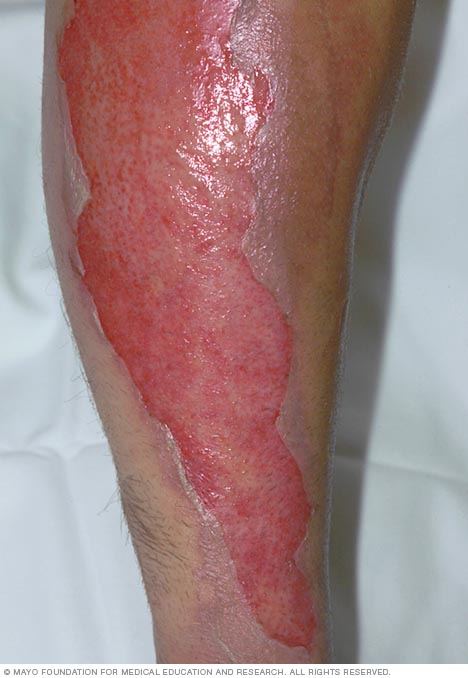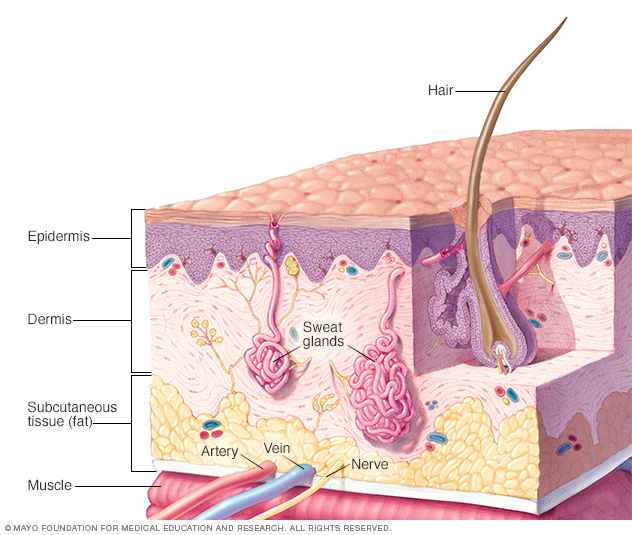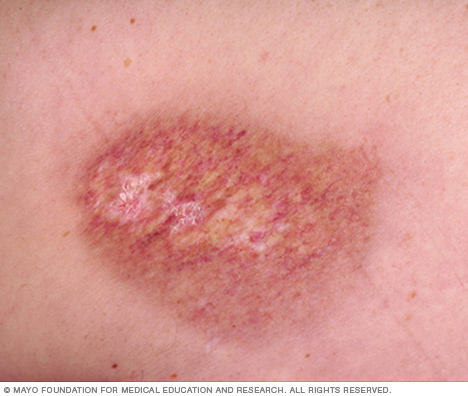Burns are tissue damage that results from heat, overexposure to the sun or other radiation, or chemical or electrical contact. Burns can be minor medical problems or life-threatening emergencies.
The treatment of burns depends on the location and severity of the damage. Sunburns and small scalds can usually be treated at home. Deep or widespread burns need immediate medical attention. Some people need treatment at specialized burn centers and monthslong follow-up care.

A second-degree burn, which often looks wet or moist, affects the first and second layers of skin (epidermis and dermis). Blisters may develop and pain can be severe.
Symptoms
Burn symptoms vary depending on how deep the skin damage is. It can take a day or two for the signs and symptoms of a severe burn to develop.
- 1st-degree burn. This minor burn affects only the outer layer of the skin (epidermis). It may cause redness and pain.
- 2nd-degree burn. This type of burn affects both the epidermis and the second layer of skin (dermis). It may cause swelling and red, white or splotchy skin. Blisters may develop, and pain can be severe. Deep second-degree burns can cause scarring.
- 3rd-degree burn. This burn reaches to the fat layer beneath the skin. Burned areas may be black, brown or white. The skin may look leathery. Third-degree burns can destroy nerves, causing numbness.
When to see a doctor
Seek emergency medical assistance for:
- Burns that cover the hands, feet, face, groin, buttocks, a major joint or a large area of the body
- Deep burns, which means burns affecting all layers of the skin or even deeper tissues
- Burns that cause the skin to look leathery
- Burns that appear charred or have patches of black, brown or white
- Burns caused by chemicals or electricity
- Difficulty breathing or burns to the airway
Take first-aid measures while waiting for emergency assistance.
Call your doctor if you experience:
- Signs of infection, such as oozing from the wound, increased pain, redness and swelling
- A burn or blister that's large or doesn't heal in two weeks
- New, unexplained symptoms
- Significant scarring

Your skin has three layers that house your sweat and oil glands, hair follicles, melanocytes, and blood vessels.

Third-degree burns extend into the fat layer that lies beneath the dermis. The skin may appear stiff, waxy white, leathery or tan. These types of burns usually require skin grafts for wound closure.

Radiation burns can be caused by X-rays or radiation therapy to treat cancer.
Causes
Burns are caused by:
- Fire
- Hot liquid or steam
- Hot metal, glass or other objects
- Electrical currents
- Radiation, such as that from X-rays
- Sunlight or other sources of ultraviolet radiation, such as a tanning bed
- Chemicals such as strong acids, lye, paint thinner or gasoline
- Abuse
Complications
Complications of deep or widespread burns can include:
- Bacterial infection, which may lead to a bloodstream infection (sepsis)
- Fluid loss, including low blood volume (hypovolemia)
- Dangerously low body temperature (hypothermia)
- Breathing problems from the intake of hot air or smoke
- Scars or ridged areas caused by an overgrowth of scar tissue (keloids)
- Bone and joint problems, such as when scar tissue causes the shortening and tightening of skin, muscles or tendons (contractures)
Prevention
To reduce the risk of common household burns:
- Never leave items cooking on the stove unattended.
- Turn pot handles toward the rear of the stove.
- Don't carry or hold a child while cooking at the stove.
- Keep hot liquids out of the reach of children and pets.
- Keep electrical appliances away from water.
- Check the temperature of food before serving it to a child. Don't heat a baby's bottle in the microwave.
- Never cook while wearing loosefitting clothes that could catch fire over the stove.
- If a small child is present, block his or her access to heat sources such as stoves, outdoor grills, fireplaces and space heaters.
- Before placing a child in a car seat, check for hot straps or buckles.
- Unplug irons and similar devices when not in use. Store them out of reach of small children.
- Cover unused electrical outlets with safety caps. Keep electrical cords and wires out of the way so that children can't chew on them.
- If you smoke, never smoke in bed.
- Be sure you have working smoke detectors on each floor of your home. Check them and change their batteries at least once a year.
- Keep a fire extinguisher on every floor of your house.
- When using chemicals, always wear protective eyewear and clothing.
- Keep chemicals, lighters and matches out of the reach of children. Use safety latches. And don't use lighters that look like toys.
- Set your water heater's thermostat to below 120 F (48.9 C) to prevent scalding. Test bath water before placing a child in it.
Also be alert to burn risks outside the home, especially if you are in places with open flames, chemicals or superheated materials.
Diagnosis
If you go to a doctor for burn treatment, he or she will assess the severity of your burn by examining your skin. He or she may recommend that you be transferred to a burn center if your burn covers more than 10 percent of your total body surface area, is very deep, is on the face, feet or groin, or meets other criteria established by the American Burn Association.
Your doctor will check for other injuries and might order lab tests, X-rays or other diagnostic procedures.
Treatment
Most minor burns can be treated at home. They usually heal within a couple of weeks.
For serious burns, after appropriate first aid and wound assessment, your treatment may involve medications, wound dressings, therapy and surgery. The goals of treatment are to control pain, remove dead tissue, prevent infection, reduce scarring risk and regain function.
People with severe burns may require treatment at specialized burn centers. They may need skin grafts to cover large wounds. And they may need emotional support and months of follow-up care, such as physical therapy.
Medical treatment
After you have received first aid for a major burn, your medical care may include medications and products that are intended to encourage healing.
- Water-based treatments. Your care team may use techniques such as ultrasound mist therapy to clean and stimulate the wound tissue.
- Fluids to prevent dehydration. You may need intravenous (IV) fluids to prevent dehydration and organ failure.
- Pain and anxiety medications. Healing burns can be incredibly painful. You may need morphine and anti-anxiety medications — particularly for dressing changes.
- Burn creams and ointments. If you are not being transferred to a burn center, your care team may select from a variety of topical products for wound healing, such as bacitracin and silver sulfadiazine (Silvadene). These help prevent infection and prepare the wound to close.
- Dressings. Your care team may also use various specialty wound dressings to prepare the wound to heal. If you are being transferred to a burn center, your wound will likely be covered in dry gauze only.
- Drugs that fight infection. If you develop an infection, you may need IV antibiotics.
- Tetanus shot. Your doctor might recommend a tetanus shot after a burn injury.
Physical and occupational therapy
If the burned area is large, especially if it covers any joints, you may need physical therapy exercises. These can help stretch the skin so that the joints can remain flexible. Other types of exercises can improve muscle strength and coordination. And occupational therapy may help if you have difficulty doing your normal daily activities.
Surgical and other procedures
You may need one or more of the following procedures:
- Breathing assistance. If you've been burned on the face or neck, your throat may swell shut. If that appears likely, your doctor may insert a tube down your windpipe (trachea) to keep oxygen supplied to your lungs.
- Feeding tube. People with extensive burns or who are undernourished may need nutritional support. Your doctor may thread a feeding tube through your nose to your stomach.
- Easing blood flow around the wound. If a burn scab (eschar) goes completely around a limb, it can tighten and cut off the blood circulation. An eschar that goes completely around the chest can make it difficult to breathe. Your doctor may cut the eschar to relieve this pressure.
- Skin grafts. A skin graft is a surgical procedure in which sections of your own healthy skin are used to replace the scar tissue caused by deep burns. Donor skin from deceased donors or pigs can be used as a temporary solution.
- Plastic surgery. Plastic surgery (reconstruction) can improve the appearance of burn scars and increase the flexibility of joints affected by scarring.
Lifestyle and home remedies
To treat minor burns, follow these steps:
- Cool the burn. Hold the burned area under cool (not cold) running water or apply a cool, wet compress until the pain eases. Don't use ice. Putting ice directly on a burn can cause further damage to the tissue.
- Remove rings or other tight items. Try to do this quickly and gently, before the burned area swells.
- Don't break blisters. Fluid-filled blisters protect against infection. If a blister breaks, clean the area with water (mild soap is optional). Apply an antibiotic ointment. But if a rash appears, stop using the ointment.
- Apply lotion. Once a burn is completely cooled, apply a lotion, such as one that contains aloe vera or a moisturizer. This helps prevent drying and provides relief.
- Bandage the burn. Cover the burn with a sterile gauze bandage (not fluffy cotton). Wrap it loosely to avoid putting pressure on burned skin. Bandaging keeps air off the area, reduces pain and protects blistered skin.
- Take a pain reliever. Over-the-counter medications, such as ibuprofen (Advil, Motrin IB, others), naproxen sodium (Aleve) or acetaminophen (Tylenol, others), can help relieve pain.
- Consider a tetanus shot. Make sure that your tetanus booster is up to date. Doctors recommend that people get a tetanus shot at least every 10 years.
Whether your burn was minor or serious, use sunscreen and moisturizer regularly once the wound is healed.
Coping and support
Coping with a serious burn injury can be a challenge, especially if it covers large areas of your body or is in places readily seen by other people, such as your face or hands. Potential scarring, reduced mobility and possible surgeries add to the burden.
Consider joining a support group of other people who have had serious burns and know what you're going through. You may find comfort in sharing your experience and struggles and meeting people who face similar challenges. Ask your doctor for information on support groups in your area or online.
Preparing for an appointment
Seek emergency medical care for burns that are deep or involve your hands, feet, face, groin, buttocks, a major joint or a large area of the body. Your emergency room physician may recommend examination by a skin specialist (dermatologist), burn specialist, surgeon or other specialist.
For other burns, you may need an appointment with your family doctor. The information below can help you prepare.
List questions you want to ask your doctor, such as:
- Do I need treatment for the burn?
- What are my treatment options and the pros and cons of each?
- What are the alternatives to the primary approach that you're suggesting?
- Can I wait to see if the burn heals on its own?
- Do I need prescription medication, or can I use over-the-counter medications to treat the burn?
- What results can I expect?
- What skin care routines do you recommend while the burn heals?
- What kind of follow-up, if any, will I need?
- What changes in my skin might I expect to see as it heals?
What to expect from your doctor
Your doctor is likely to ask you a number of questions, such as:
- How did the burn occur?
- Do you have other symptoms?
- Do you have underlying health conditions, such as diabetes?
- What at-home burn treatments have you used, if any?
- Have you noticed any changes in the appearance of the burn?
Copyright © 1998-2025 Mayo Foundation for Medical Education and Research (MFMER). All rights reserved.